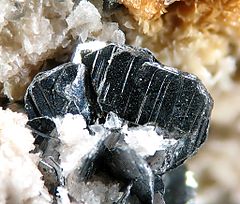- Nagyagite
-
Nagyagite 
Nagyagite from Nagyag (Săcărâmb), Romania (image width: 1.5 mm)General Category Sulfosalt mineral Chemical formula Pb5Au(Te,Sb)4S5-8[1] or AuPb(Sb,Bi)Te2-3S6[2] or (Te, Au)Pb(Pb, Sb)S2[3] Strunz classification 02.HB.20a Dana classification 02.11.10.01 Identification Colour Blackish lead-grey; pale grey in polished section Crystal habit Tabular crystals (often bent), also massive granular Crystal system Monoclinic, pseudotetragonal. Point Group: 2/m. Twinning Crossed twin lamellae observed on (001) sections Cleavage Perfect on {010}, excellent on {101} Fracture Hackly Tenacity Flexible, slightly malleable Mohs scale hardness 1.5 Luster Metallic, bright on fresh cleavage Streak Blackish lead-grey Diaphaneity Opaque Specific gravity 7.35–7.49 Pleochroism Weak References [3][1][2] Nagyagite (Pb5Au(Te,Sb)4S5-8) is a rare sulfide mineral with known occurrence associated with gold ores. Nagyagite crystals are opaque, monoclinic and dark grey to black coloured.
It was first described in 1845 for an occurrence at the type locality of the Nagyag mine, Sacarîmb, Hunedoara, Romania.[1][2]
It occurs in gold–tellurium epithermal hydrothermal veins. Minerals associated with nagyagite include: altaite, petzite, stutzite, sylvanite, tellurantimony, coloradoite, krennerite, native arsenic, native gold, proustite, rhodochrosite, arsenopyrite, sphalerite, tetrahedrite, calaverite, tellurobismuthite, galena and pyrite.[3]
References
- ^ a b c http://www.mindat.org/min-2830.html Mindat.org
- ^ a b c http://webmineral.com/data/Nagyagite.shtml Webmineral data
- ^ a b c http://rruff.geo.arizona.edu/doclib/hom/nagyagite.pdf Handbook of Mineralogy
This article about a specific sulfide mineral is a stub. You can help Wikipedia by expanding it.
